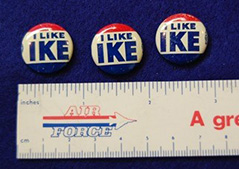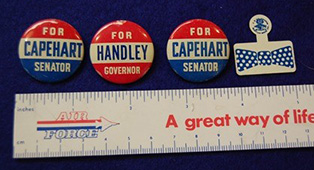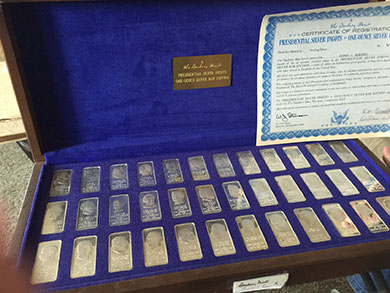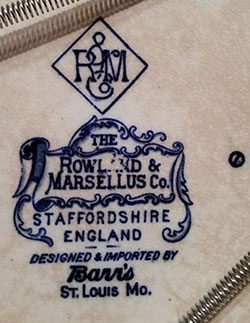 |
|
|||
 |
 |
|||
Copyright © Harry Rinker, LLC 2016 Questions
and Answers
QUESTION: When I was in the eighth grade, our teacher spent time discussing the 1956 presidential election and the 1957 Indiana state election. I have over 100 three-quarter inch “I LIKE IKE” political buttons. The blue letters are on a central white banner with a red banner above and blue banner below. I also have several “FOR / CAPEHART/ SENATOR” and “FOR / HANDLEY / GOVERNOR” three-quarter inch buttons. Finally, there is a tab with a white ground on which is a blue and white checkered bowtie. I have no idea to whom this relates. The local Republican election officer donated these pins to the school. Somehow, I wound up with many of them. Any idea what they may be worth? – RB, Sheridan, WY, Email Question 
ANSWER: “Too much of a good thing” is an old idiom that has application in the antiques and collectibles field. Governed by the law of supply and demand, the value of an antique or collectible is heavily dependent upon scarcity. Sending 100 buttons into the secondary market at one time will flood it and cause value to plummet. Your “I LIKE IKE” button, the format of which came in several sizes, already is a glut on the market. “Buy It Now” price listings from eBay sellers range from $8.00 to $14.99, with most sellers offering free shipping. Sell through is minimal to non-existent. An asking price in the $4.00 to $5.00 range is more reasonable, assuming a potential buyer is unaware of the hoard upon which you are sitting. The good news is that the buttons represent winners. Although my friends in the American Political Items Collectors (www.apic.us) may disagree, the general public prefers to collect items associated with winners rather than losers. Who remembers the losers? Take a minute and write down the losing presidential tickets for the 1964, 1972, and 1988 presidential elections. It takes some luck to name the presidential candidate, but naming his vice presidential running mate is nearly impossible. 
Homer E. Capehart served as Senator from Indiana from 1945 to 1963. Harold W. Handley was Governor of Indiana from 1957 to 1961. Given the Republican stronghold on Indiana at the time, I am certain he did not need Eisenhower’s coattail to obtain office. Handley often is pictured wearing a bowtie. Collector interest in local and state political memorabilia is largely limited to political item collectors from that particular state. Since there were fewer local and state buttons produced, their survival rate is low. The collector basis also is low. Hence, their secondary market value falls within the $5.00 to $10.00 range. When offered for sale on eBay, local election buttons often are grouped in lots of six to ten with the average asking price per button between fifty cents and one dollar. Since you reside in Wyoming and not Indiana, value for the Indiana buttons in your regions is between a dime and a quarter. This is another instance where the maximum value of an object resides in the area from which it originated. QUESTION: I have a complete set of The Danbury Mint “PRESIDENTIAL SILVER INGOTS / ONE OUNCE SILVER BAR EDITION.” The set is housed in a walnut wooden box and is accompanied by a “Certificate of Registration.” The box contains 36 ingots. What is my set worth? – DQ, Madison, WI, Email Question 
ANSWER: The complete Danbury Mint “Presidential Silver Ingots” contained 38, not 36 one-ounce silver ingots. The set, the final ingot issued around 1977, honored the presidents from George Washington to James Carter. President Cleveland was limited to one ingot, even though he served two separate terms. The ingots were sold on a monthly subscription basis. Liveauctioneers.com lists a set that sold for $3,500.00 on December 6, 2009. The weight of silver in the full set was reported to be 199.5 ounces of silver. An eBay seller is offering a complete set of 38 ingots for $2,999.00 at “Buy it Now or Best Offer.” The person who bought the set is likely having second thoughts about his investment. As of July 10, 2016, the value of an ounce of silver is $20.22. Assuming the set contains 199.5 ounces of silver as stated in the description of the set offered for sale in 2009, the value is $4,033.89. This appears fishy, especially if the set contains only 38 one-ounce bars. Does it make more sense to take $20.22 x 38. The result is $792.80. Those wishing to sell Danbury Mint silver sets are encouraged to check out the website http://www.selldanburymint.com/price-guide. The first item on the list of “Danbury Mint Want List: A List of Danbury Mint Silver Coins we Want to buy” is “The Presidential Silver Ingots Collection, 5000 grain Edition (Danbury Mint, 1975).” You have to provide your personal data before you receive a quote. A grain of silver equals .065 grams. Thus, 5000 grains are 3,250 grams. As of July 10, 2016, the price for a grain of silver is $0.65. Using this calculation, the melt value of the set is $2,112.50. The above price compilations are complicated by the difference between a standard ounce and a troy ounce, the weight measure used for precious metals. One ounce is equivalent to 0.01135 troy ounces. What does this prove? Achieving apple to apple comparisons in the antiques and collectibles trade is difficult. It also demonstrates that antiques and collectibles buyers are best advised to question every piece of information provided to them by sellers. Plucking numbers out of the air without substantiation is a problem in the trade. If you want to sell your set, my suggestion is to list it on eBay for $1,500.00. You will undercut the competition and should sell it quickly. Another route is to take it to a jeweler or other outlet that buys melt gold. If the offer is over $800.00, take it. Your final option is to find an auctioneer who sells precious metal and jewelry and let him/her sell it. If you take this route, make certain you have a clear understanding of the costs associated with the sale. QUESTION: I have a blue neckerchief from the 1935 Boy Scout Jamboree. I would like to know its value and where to sell it. – MR, Email Question ANSWER: In 1935, the Boys Scouts of America planned to hold a National Jamboree in Washington, D.C., to celebrate the 25th anniversary of the Boy Scout movement in the United States. When a polio epidemic broke out in Washington, D.C., the Jamboree was canceled. The first Jamboree took place in 1937. Dan Beard lit the opening wood campfire, composed of wood brought by Scouts from the 48 states, using flint and steel. 27,232 Scouts attended. Memorabilia such as a patch and neckerchief were issued for the 1935 Jamboree. The neckerchief with the Jamboree logo in one corner came with a blue or red background. Fakes and reproductions of Boy Scout Jamboree material is plentiful. The website mitchreis.com is an excellent source for distinguishing between period memorabilia and the reproductions and fakes. A period 1935 National Jamboree neckerchief is a full square neckerchief with a high quality screened image showing great detail and sharp line delineations. Fake 1935 National Jamboree neckerchiefs are triangular in shape and poorly screened. The capitol dome is almost solid in its color. Boy Scout memorabilia is sold at regional and national gatherings and on a variety of websites such as www.nationaljambo.com and www.scoutstuff4sale.com. Seller asking prices range between $90.00 and $125.00. Buyers with patience can buy an example in the $75.00 range. Value is contingent upon the condition of the screened logo and correct color of blue and red. Heavily worn and washed examples sell for much less. [Author’s Aside: I was one of the over 52,000 individuals who participated in the fourth National Jamboree held at Valley Forge from July 12, 1957 to July 18, 1957. I represented the Minsi Trails Council, headquartered in Bethlehem, Pennsylvania.] QUESTION: I have a Rowland and Marsellus “Souvenir of St. Louis, Mo.” plate made exclusively for Barr’s of St. Louis. My question concerns a small circle with a line through its center located next to the main back-stamp mark. What does it signify? – GR, Email Question 
ANSWER: My best guess is that it is a quality or approval mark. As souvenir plates worked their way through the manufacturing process, they were checked for quality. The decal images on the front of the plate were applied by hand. The mark could indicate the plate was approved to move forward to the next production step. Another possibility is a symbol for a special order, reminding final packer to make certain the plate did not become part of a general shipment. If a “Rinker on Collectibles” reader has a better guess, email me at harrylrinker@aol.com. Harry L. Rinker welcomes questions from readers about
collectibles, those mass-produced items from the twentieth and twenty-first centuries.
Selected letters will be answered in this column.
Harry cannot provide personal answers.
Photos and other material submitted cannot be
returned.
Send your questions to: Rinker on Collectibles, 5955 Mill
Point Court SE, Kentwood, MI 49512.
You also can e-mail your questions to
harrylrinker@aol.com.
Only e-mails containing a full name and mailing address
will be considered.
You can listen
and participate in
WHATCHA GOT?, Harry’s
antiques and collectibles radio call-in show, on Sunday mornings between 8:00 AM
and 10:00 AM Eastern Time.
If you
cannot find it on a station in your area,
WHATCHA GOT?
streams live on the Internet at www.gcnlive.com.
SELL, KEEP OR TOSS?: HOW TO DOWNSIZE A HOME,
SETTLE AN ESTATE, AND APPRAISE PERSONAL PROPERTY
(House of Collectibles, an imprint of Random House Information Group, $17.99),
Harry’s latest book, is available at your favorite bookstore and via
www.harryrinker.com.
|
||||